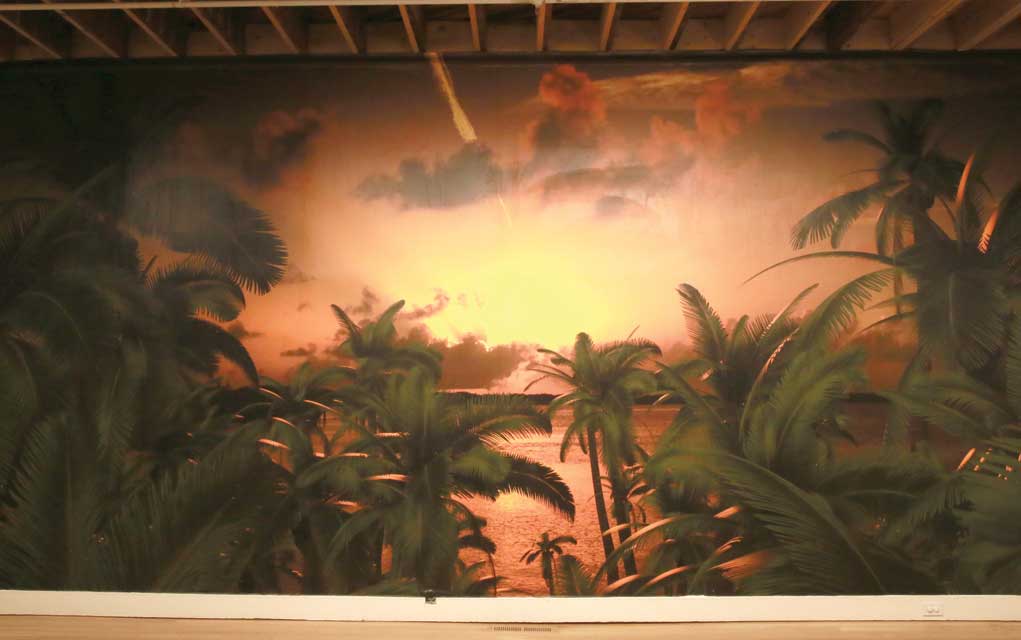
When first walking into BMoCA’s latest show, Artifacts & Other Errors of Perception, none of the pieces seem to relate to one another. There are various mediums from photography to sculpture, a lounge area, a mini fridge and even a skull in an aquarium. The seeming chaos of ideas creates an intentional illusion of reality in Austrian-born artist Mathias Kessler’s exhibition. In the show, Kessler creates a wunderkramer, or a “cabinet of curiosities.”
“I would say to anyone walking in that you’re going to be walking in between kind of reality and fantasy. And what that is, what one’s reality and which one’s fantasy, is really up to you to kind of discover,” says Mardee Goff, curator at BMoCA.
Now showing through May 29, Artifacts & Other Errors of Perception is Kessler’s first solo exhibit in America. In the exhibit, he challenges and examines humanity’s relationship with and connection to the environment. While that theme may seem grandiose and complicated, it allows much room for interpretation, which is Kessler’s intention.
“I ask a lot of questions and people can answer them or (recognize that) whatever they see in it should be fairly open-ended,” he says. “I realized some time ago that I can’t control it anyway. People will make up their own minds, it’s just the way it should be, actually. And I hope for that.”
While the pieces in the exhibit may not seem to be connected at first, the undertones of each relate back to perception. “Touching Antiquity” is a piece on an iPad that allows the viewer to use the Smithsonian Museum’s website to view Hiram Power’s sculpture “Greek Slave.” Goff questions which experience is more real: seeing a sculpture up on a pedestal or experiencing the piece digitally, providing a close-up look and the ability to zoom in and out and move the perspective. The way we experience art has been the same for many years, but this piece offers a new way to engage with it.

Another piece in the show deals in illusion. At first “Sunset in Simulacrum_03” seems like the ideal tropical sunset, the perfect place for a vacation: relaxing, beautiful and serene. But as beautiful as the scene is, it is actually computer-generated, challenging the viewer’s perception of natural beauty.
In a more sinister-looking piece, “Nowhere to be Found,” coral slowly eats away at a human skull, which rests in a living aquarium.
“The skull is being disintegrated,” Goff explains. “It’s being eaten by the coral and eventually it would be completely engulfed and gone. So it further punctuates our human mortality, the reality of the mortality of our image and our mark on this world, and how there is a much larger force at work.”
In the aquarium, nature is taking from humans, as we have been taking from nature for hundreds of years.
“I think of it as a visceral experience where the viewer can engage in a reality that happens in front of their eyes…” Kessler says. “The skull submerged in the seawater with corals colonizing it and covering it, I think of it as an image of death, but also a process of life and an artificial ecosystem that evolves in front of you.”
Nature is a common theme throughout Kessler’s pieces. For “Ilulissant 011_03” and “Ilulissant S010,” Kessler took a boat trip off the coast of Greenland in the middle of the night to capture images of icebergs. He used massive amounts of wattage to light up the icebergs for the photographs, creating a stark contrast between the white ice and the ink-black sky.

In his work, Kessler attempts to go beyond simply showing images of the natural world by challenging our preconceived notions. “For me, I’m trying to look into the image of nature, how we see nature,” he says. “If you live in Boulder, you live in the greenest city in America, that’s what you guys claim. So there’s this image of Boulder being the greenest city, having a great outdoors experience. But then also looking at the darker side of how we use nature, be it climate change, energy production, be it suburban development and how cities enclose onto nature and the usage of land.”`
Many of the pieces in the show have been exhibited before, but Kessler says that these pieces are viewed differently as the world changes. According to Kessler, art has a dual purpose, and this exhibit checks both boxes.
“I think art should fulfill an aesthetic pleasure on one hand but the art also should reflect on our times,” Kessler says.
Considering the current political atmosphere, Kessler and many of his exhibit’s viewers believe the pieces achieve new meaning and are more relevant now than ever.
Cultural Cul-de-sac
Going beyond the typical art show, Kessler wanted to open the exhibit to the community. Within Artifacts & Other Errors of Perception, he created a lounge space filled with tables and a bar designed by Kessler. Every Thursday night, this room turns into a sort of social sculpture functioning as an artistic open mic night. But Cultural Cul-de-sac pushes beyond the boundaries of a typical open mic night and opens its stage to anything and everything, from poetry, to cooking, to film and more. For these events, BMoCA reached out to the community and received more than 100 submissions.
Goff says that “in producing what is an image and reflection of Boulder, we wanted to fill it in with the culture of Boulder.”
The parameters of the evenings are wide so people can express their passions however they choose, showing that art is not defined or limited by anything other than one’s own creativity. This has varied from a Women’s Huddle that facilitated a discussion on misogyny to a fly-tying demonstration that turned something utilitarian into an art form.
These events take the broad view of culture that runs through the exhibit and zooms in on Boulder’s culture and even Boulder’s own errors of perception. Kessler says that his childhood in Austria helped him identify with Boulder, saying that it “certainly reminded me about the place that I come from and reminded me about the conflict of trying to be this very beautiful place but also dealing with the problems of being a beautiful place and everyone wanting to move there.”
Nicole Dial-Kay, BMoCA’s director of education, says that the Cultural Cul-de-sac reflects the uniqueness of Boulder’s community.
“I think the magic of this is that it’s always different,” she says. “They’re always unique perspectives on how people express their creativity and their desire to make. I think that’s kind of the power of opening this platform up to the community, which is dynamic and creative and inspiring.”
On the Bill: Mathias Kessler: Artifacts & Other Errors of Perception. Boulder Museum of Contemporary Art, 1750 13th St., 303-443-2122. Through May 29. Cultural Cul de Sac. OFF Cinema presents ’twas always darkest closest the sun — International Video Shorts. Thursday, May 11, 5 p.m. An Evening with Mathias Kessler. Thursday, May 25, 5 p.m.














